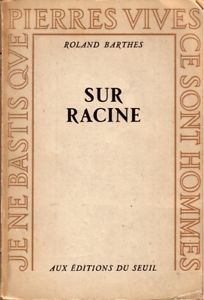Over Christmas I read Memoirs of a Leavisite by David Ellis, Emeritus Professor of English at the University of Kent. It left me no more of a fan of the great F. R. Leavis than I was when I began, but it made me realise how much his theories of literature might still flow beneath the surface of my own reading and teaching–so I read it both with pleasure and with a kind of fascinated horror.
As befits someone brought up in Leavis’s school, Ellis confesses that he has little feel for or interest in books as material objects, though he admits one exception: the works of Roland Barthes in the Éditions du Seuil:

“As he became more famous he was able to publish shorter texts in this format, with bigger print, so that his book on photography (La Chambre Claire), with its wonderful expanses of white around the large lettering, became my model of what a book should look like, especially at a time when English academic publishers were cramming more and more words onto the enlarged pages, and thinner paper, of their books. With my eyesight weakening, I became a propagandist for this model until someone publishing one of my own books rather irritably told me that she was considering offering it to the public with a free white stick (an addition, I ought to have pointed out, that would not help the poorly sighted to read the print better).”
As well as saying a lot about the unending tussle between writers and publishers, and the hidden visual cues that shape our reading, this is also a good example of Ellis’s richly maudlin prose–perfect reading for a dark December day…